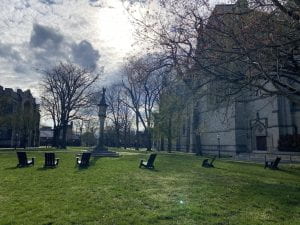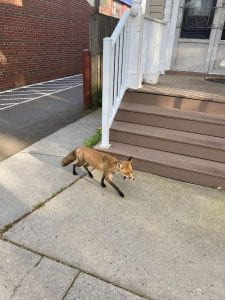For many on the US east coast, including international doctoral students like myself, the COVID-19 pandemic here in March 2020 changed the structure of life and work for the foreseeable future. In mid-March, the state of New Jersey “strongly recommended” that residents stay at home between 8 p.m. and 5 a.m. Over the week of spring recess (March 14–22), the university town of Princeton saw off most of its undergraduates and some graduate students. Undergraduate students took their mid-term exams the week before the spring recess. As a “preceptor” (equivalent to an Assistant in Instruction, or a Teaching Assistant), I witnessed how the exams were changed from “in-class” to an online format: this was decided mid-week, after some distressed students petitioned for such a move. Timelines matter in understanding institutional decision-making regarding COVID-19. This, I suspect, will be a recurring theme of the story in the following weeks and months.
The condition of “social distancing” has warranted an alternative reading of normalcy, one that allows us to not be in control all the time. Spring continues to work wonders on local flora and fauna. Campus squirrels chase one another from tree to tree. Occasionally a vulture breaks into view, its wings gliding through the crisp air, at a height of about twenty-five “social distances” away. None of these would have had my sustained attention on a “normal” weekday before the pandemic. Or are they a result of nature bouncing back where human activities are reduced? Halting on-site teaching and research, a prestigious and privileged university also becomes, quickly and practically, a reserve of nature and of memory. This change reminds us of how much deliberation is actually required for the upkeep of any ostensibly solid human institution, this one included. What does “normalcy” really mean—or, where does human agency lie—if decay is the long-term constant?


Remote Teaching
By the second week of April, three weeks after our “precept” (tutorial) sessions moved to Zoom, some of my students were still on campus. Others had gone home, and except for one student who is based in Asia and has to wake up very early in the morning, most students are unaffected by a major time difference. This is helped by the fact that the professors teaching this class have chosen to record their lectures, making it easier for everyone to access the lectures at a convenient time.
The precepts, where students and I convene to discuss assigned readings in tandem with lectures and textbook materials, are still held in real time. For teachers and students alike, the pandemic disrupted what was supposed to be a normal spring semester on site. Teaching online brings to the fore the importance of in-person interaction. Though the class content is the same, the in-person format is easier for all of us to pick up and give out social cues—an indispensable part of our education. According to some people (fellow graduate students included), being in the room also makes memory more vivid because it stimulates all senses, while “zooming” in and out simply does not have the same physical quality. All this is not to deny what technology offers us: convenience and flexibility.
On screen, my students all looked relaxed. They also made sure to ask how I was doing in our correspondence. Just this week, they engaged in a “real” debate about the role of ideology in post-WWII history—“real” in the sense that they disagreed with one another and tried to change others’ mind by citing evidence from course materials. This is a good sign of sustained focus and engagement with class content. That said, it is still important for me to keep an eye out for traces of anxiety, which may manifest differently since some students are about to graduate and others are just finishing their first year at Princeton.
Admittedly, at one point I had experienced a feeling of detachment and had doubts about whether it is meaningful to try to maintain the status quo and pretend everything can be “normal.” It remains apropos to think critically about “normalcy” that is imposed to gloss over institutional failings. The curated institutional “normalcy” takes the form of, for instance, continuous floods of emails about routine administrative matters, professional development programs, workshops, seminars, and “happy hour” gatherings on Zoom. The ambience created therewith encourages faculty and graduate students to keep themselves busy, wait out the pandemic, and prepare for the resumption of productivity afterwards. Yet when it comes to working with my undergraduate students on an interpersonal level, I think it would be more helpful for them to venture collectively into the past for at least an hour in our weekly meetings. It is then up to them to decide whether by doing so they want to take a break from reality or to make sense of the current situation through history.
Community in the Time of COVID-19
I recently have moved into an off-campus house with some friends in order to pre-empt isolation in the prospect of a lockdown. Moving north of Nassau Street—away from campus buildings and University housing in the south—was not much of a geographic adventure. Yet it could be interpreted as a physical metaphor of crossing a north-south divide in Princeton. The site of knowledge production (south) is visibly distinct from a suburban neighborhood (north). The east-west artery, Nassau Street, demarcates the two geographies and decorates the area with restaurants, cafes, boutiques, souvenir shops, and so on. Walking out of the main campus gate, you arrive at a T-shaped traffic junction. Across the street to your left is a bank; right, a jewelry store.
Beyond Nassau Street, I know very little. As an international student throughout my career in higher education, I had moved from place to place without feeling a need to engage with the local community. My understanding of the social fabric of a given locality is therefore very thin. Who else lives here? Since when? How is their life different from mine or my peers? What do townspeople make of us? How does local society function collectively, if town and gown hardly cross path in a conscious and meaningful way? These are questions I am yet to ponder.
Zheng Guan is a doctoral candidate in History at Princeton University. Zheng works on historical conservation and the making of heritage in twentieth-century China. Her dissertation explores several threads: intellectual conceptualization of “heritage” and “conservation,” state policies on urban planning, as well as social contexts in which “conservation” became thinkable and was implemented. She can be reached through email: z.guan at princeton.edu.
***
![[Teach311 + COVID-19] Collective](https://blogs.ntu.edu.sg/teach311/files/2020/04/Banner.jpg)